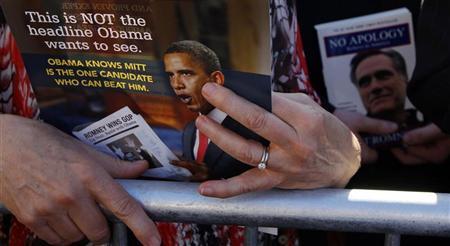(Reuters) – With a sweep of three presidential primaries on Tuesday, Mitt Romney
graduated from Republican front-runner to underdog in a November match-up against Democratic President Barack
Obama.

leaflet, which includes a photograph of U.S. President Barack Obama from "Restore Our Future", while attending an
event with Republican presidential candidate and former Massachusetts Governor Mitt Romney at Paramount Printing in
Jacksonville, Florida January 26, 2012. REUTERS/Brian Snyder
Romney’s wins in Wisconsin, Maryland and Washington, D.C. gave him a prohibitive lead in the battle
for the Republican presidential nomination, analysts said, and effectively consigned chief rival Rick Santorum to also-ran
status.
Now the former Massachusetts governor faces an uphill climb as he takes on a well-funded opponent who travels
to campaign events by Air Force One.
The jousting already has begun.
Obama criticized Romney by name while
blasting a Republican budget plan on Tuesday, a move the president had avoided until now. Romney made no mention of Santorum
or any other Republican rivals in his victory speech in Wisconsin late Tuesday, focusing instead on Obama.
“In Barack
Obama’s government-centered society, the government must do more because the economy is doomed to do less,” Romney told
supporters in Milwaukee. “When you attack business and vilify success, you will have less business and less
success.”
As Romney pivots to take on Obama in the November 6 election, he faces a daunting to-do list.
He must
heal still-raw divisions within the Republican Party and build enthusiasm among party activists, especially conservatives who
view him with suspicion.
He must raise hundreds of millions of dollars and ramp up his campaign to close a
fund-raising gap with Obama, whose campaign has spent the past four years refining its voter-targeting operation and
establishing a significant presence in nearly every state.
And Romney must reach out to women, independents and other
voters who have been turned off by a bitter, drawn-out Republican nominating process. Romney occasionally has been forced
from his core economic message to comment on divisive social issues — including abortion and contraception — that Santorum
helped push onto the agenda.
“It is clearly Santorum’s fault that Romney’s favorable among women and independents
collapsed,” said Cal Jillson, a political science professor at Southern Methodist University. “He forced Romney to the right
on social issues, where he was uncomfortable and unconvincing.”
Recent polls indicate Romney has a lot of work to
do.
A USA TODAY/Gallup Poll released on Monday showed Romney trailing Obama by 4 percentage points in a head-to-head
match-up, the widest gap since voting started in January.
Among the independent voters who will decide the election,
the gap stretched to 8 points.
“What matters now is, how does Romney grow as a candidate?” said Republican consultant
Matt Mackowiak. “Can he unify conservatives? Can he raise hundreds of millions over the next seven months? What vision will
he lay out for the country?”
‘FLAG HAS DROPPED’ ON FALL CAMPAIGN
Romney has amassed more than half of the
1,144 delegates needed to clinch the Republican nomination, but he may not reach the total until June. Still, party
strategists say the race is effectively over and the mano-a-mano match-up with Obama essentially has begun.
“That flag
has dropped,” Republican strategist Rich Galen said. “We’re for all intents and purposes in the general
election.”
Obama seems to agree.
On Tuesday, as well as slamming Romney for backing a controversial budget plan
advanced by Republicans in the U.S. House of Representatives, Obama’s campaign also aired its first television ad attacking
Romney, for supporting oil companies.
Obama’s budget attack illustrates the precarious situation Romney is in as he
reaches out to moderate voters.
Romney campaigned extensively in Wisconsin with the Republican budget plan’s author,
Representative Paul Ryan — a move likely to win points with Tea Party conservatives who seek limited government and have
viewed Romney with suspicion.
Romney’s embrace of Ryan may shore up his right flank, but it could leave him
vulnerable among moderates.
Democrats plan to use the Ryan budget plan as Exhibit A in their argument that Republicans
would gut popular benefit programs such as Medicare, the government-run health plan for retirees. Those joint Romney/Ryan
campaign stops could resurface in Democrats’ attack ads in the coming months.
Fortunately for Romney, he will be able
to respond easily.
Romney supporters will have no problem raising enough money to match Obama on the airwaves, thanks
to loosened campaign-finance rules that have
enabled independent “Super PACs” to raise unlimited amounts of money. The Super PAC that backs Romney had raised $43.2
million as of the end of February, while the Super PAC that supports Obama had raised just $6.3 million.
Obama and his
Democrats have fared better in their fund-raising efforts for the president’s campaign, raising a total of $322 million by
the end of February. Romney’s campaign had raised just under $75 million by that point, while the Republican National
Committee had raised $120 million.
Romney and the party have announced plans to coordinate their activities, an
approach that should allow them to dramatically boost their fund-raising totals.
Even so, analysts say, Romney will
likely not be able to match Obama’s voter-turnout operation, or his sophisticated Internet strategy that will enable his
campaign to gather an unprecedented amount of data about voters.
Romney also doesn’t command the vast resources of
the federal government. On Obama’s orders, federal workers can alleviate flooding in a crucial swing state or wipe out an
al-Qaeda operative on the other side of the globe.
On the other hand, unlike Obama, Romney won’t be held responsible
if gasoline prices continue to rise or the U.S. economic recovery loses steam. In an election that both sides expect to be
close, any event could tip the balance.
“April to November in American politics is a very long time,” said Mark
Brewer, a political science professor at the University of Maine.
(Editing by David Lindsey and David Brunnstrom)





